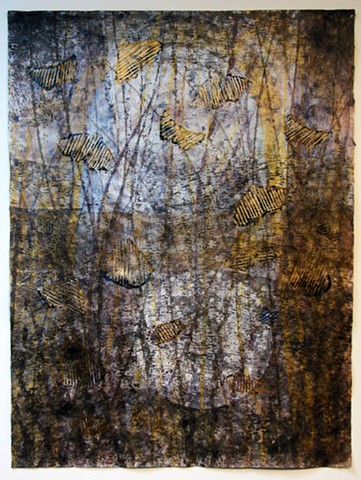Moths Entering Moonlight
Moths Entering Moonlight
(three paintings about Autumn)
Passage into dark
Mountains over which the moon
Presides so brilliantly. . .
Not seeing it, I’d have missed
This passage into my own past.
-SAIGYO
(1118-1190) Japan *
During the last several evenings the temperature shifted from frost-delivering chill to a seemingly balmy upper 40’s. Prior to the frost, a multitude of moths appeared at our windows struggling against the glass in an effort to reach the lights inside. These must have had the quality of a solar or lunar beacon for the moths and when some finally appeared inside the house they would crash into the hot bulbs, then dive or fall away only to climb back into contact with the lights.
When our night temperatures plunged and frost took some remaining garden plants, the moths seemed to have perished as well. But on subsequent and warmer evenings they re-emerged from out of the darkness and assailed the windows and porch lights again. Where did they go in the interim and where will they fly off to when autumn becomes unbearable?
The moon and mountains are a perennial subject for Saigyo and feature prominently
In his tanka poems about the seasons. There is a both a softness like the body and wings of most common moths, and a vast sense of space and time to these poems. They are direct and elusive, simple descriptions always with metaphoric distances to explore or take in.
If I could ask Saigyo where the moths go perhaps he might suggest that they fly towards the light of the autumn moon where they become a part of its distant, soft light until Spring when suddenly they are shadows on his paper walls or at our dark night windows.
These fragile creatures seem to defy time, and with their rapid flight also confound our ability to trace their passages in and out of the light. These paintings, like most, are bound to the moments of time during which they are viewed. They may record a sequence of time but the duration perceived is always limited to the time we spend visually scanning their surfaces. The surfaces of these three paintings represent the texture of autumn and the passage of moths towards the moon. I hope they inspire long, deliberate views that allow for simple meditation.
*from Mirror for the Moon A Selection of poems by SAIGYO
translated by Wm. R. LaFleur
New Directions 1977,78
